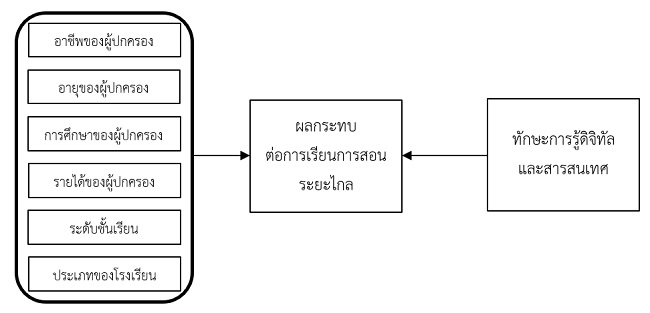การวิเคราะห์ความคิดเห็นของผู้ปกครองนักเรียนระดับชั้นประถมศึกษาต่อการรู้ดิจิทัลและสารสนเทศและผลกระทบจากการเรียนในระบบทางไกลในช่วงการแพร่ระบาดเชื้อไวรัสโคโรนาสายพันธุ์ใหม่ 2019 (โควิด-19)
DOI:
https://doi.org/10.14456/nrru-rdi.2021.55คำสำคัญ:
การรู้ดิจิทัลและสารสนเทศ, ผลกระทบจากโควิด-19, การเรียนในระบบทางไกล, นักเรียนชั้นประถมศึกษาบทคัดย่อ
การวิจัยเชิงสำรวจนี้มีวัตถุประสงค์เพื่อเปรียบเทียบความคิดเห็นของผู้ปกครองนักเรียนต่อผลกระทบจากการเรียนในระบบทางไกลของนักเรียนระดับชั้นประถมศึกษาในช่วงการแพร่ระบาดเชื้อไวรัสโคโรนาสายพันธุ์ใหม่ 2019 (โควิด-19) และเพื่อศึกษาอิทธิพลของความคิดเห็นของผู้ปกครองนักเรียนต่อทักษะการรู้ดิจิทัลและสารสนเทศของนักเรียนประถมศึกษาต่อผลกระทบจากการเรียนในระบบทางไกลของนักเรียนระดับชั้นประถมศึกษาในช่วงการแพร่ระบาดเชื้อไวรัสโคโรนาสายพันธุ์ใหม่ 2019 (โควิด-19) เก็บรวบรวมด้วยแบบสอบถามออนไลน์จากกลุ่มตัวอย่าง จำนวน 421 คน โดยการสุ่มแบบสะดวก วิเคราะห์ข้อมูลด้วยการแจกแจงความถี่ ร้อยละ ค่าเฉลี่ย และส่วนเบี่ยงเบนมาตรฐาน และการวิเคราะห์การถดถอยเชิงพหุคูณ ผลการวิจัย พบว่า กลุ่มตัวอย่างมีความเห็นว่าได้รับผลกระทบจากการเรียนในระบบทางไกลของเด็กในปกครองในระดับปานกลาง ( =3.03, SD=0.82) เป็นผลกระทบด้านการจัดการเรียนการสอนและสิ่งสนับสนุนทางการศึกษามีค่าเฉลี่ยมากที่สุด ( =3.34, SD=0.93) การทดสอบความแตกต่างของกลุ่มตัวอย่างต่อความเห็นเรื่องผลกระทบการเรียนในระบบทางไกล พบว่า กลุ่มตัวอย่างที่มีอาชีพและมีเด็กในปกครองที่ศึกษาในระดับชั้นที่แตกต่างกัน มีความเห็นรายด้านของผลกระทบไม่แตกต่างกันอย่างมีนัยสำคัญทางสถิตที่ระดับ 0.05 ส่วนกลุ่มตัวอย่างที่มีอายุ ระดับการศึกษา รายได้ และประเภทของโรงเรียนที่เด็กกำลังศึกษาอยู่แตกต่างกัน มีความเห็นต่อผลกระทบในรายด้านแตกต่างกันอย่างมีนัยสำคัญทางสถิติที่ระดับ 0.05 การวิเคราะห์ความคิดเห็นต่อระดับการรู้ดิจิทัลและสารสนเทศของนักเรียนชั้นประถมศึกษาในภาพรวมอยู่ในระดับปานกลาง ค่าเฉลี่ยเท่ากับ 2.06 (SD=0.47) ด้านการจัดการและการสื่อสารสารสนเทศที่ค้นหา มีค่าเฉลี่ยสูงที่สุดเท่ากับ 2.16 (SD=0.56) และพบว่า ตัวแปรพยากรณ์ที่มีอิทธิพลต่อผลกระทบจากการเรียนในระบบทางไกลอย่างมีนัยสำคัญทางสถิติที่ระดับ 0.05 ได้แก่ ความเข้าใจและมีส่วนร่วมในการทำงานในรูปแบบดิจิทัล (Beta=-0.193) การจัดการและการสื่อสารสารสนเทศที่ค้นหา (Beta=-0.359) และการทำงานร่วมกับผู้อื่นและสามารถเผยแพร่สารสนเทศดิจิทัล (Beta=0.234)
References
Andrew, A. et al. (2020) Learning during the lockdown: real-time data on children’s experiences during home learning, The Institute for Fiscal Studies. Retrieved January 7, 2021, from https://ifs.org.uk/uploads/Edited_Final-BN288%20Learning%20during%20the%20lockdown.pdf
Bawden, D & Robinson, L. (2012). Introduction to Information Science. London, England : Facet Publishing.
Comer, D. R., Lenaghan, J. A., & Sengupta, K. (2015). Factors That Affect Students’ Capacity to Fulfill the Role of Online Learner. Journal of Education for Business, 90(3), 145–155.
Cordell, R.M. (2013). Information Literacy and Digital Literacy: Competing or Complementary?. Communications in Information Literacy, 7(2), 177-183.
Daly, M. C., Buckman, S. R., & Seitelman, L. M. (2020). The Unequal Impact of COVID-19: Why Education Matters. FRBSF Economic Letter, 2020-17, 1-5.
DeFleur, M. L. & Ball-Rokeach, Sandra J. (1989). Theories of mass communication (5th ed.). New York : Longman.
Dragomir, C., & Munteanu, A. (2020). Impact of Online Education on Economic Students’ Professional Training in the Context of the Covid-19 Pandemic. Review of General Management, 31(1), 41–55.
Durham, F. (2013). Using a Digital and Information Literacy Framework to underpinned skills development for distance learners studying at The Open University, UK. In Kurbanoğlu S., Grassian E., Mizrachi D., Catts R., Špiranec S. (eds) Worldwide Commonalities and Challenges in Information Literacy Research and Practice. ECIL 2013. Communications in Computer and Information Science, (p. 397). Springer, Cham.
Ferrari A., Punie Y., & Redecker C. (2012). Understanding Digital Competence in the 21st Century: An Analysis of Current Frameworks. In Ravenscroft A., Lindstaedt S., Kloos C.D., Hernández-Leo D. (eds) 21st Century Learning for 21st Century Skills. EC-TEL 2012. Lecture Notes in Computer Science, 7563, 79-92. https://doi.org/10.1007/978-3-642-33263-0_7
Freedman, D., Pisani, R., & Purves, R. (2021). Statistics. New York : W.W Norton & Company.
Hague, C., & Williamson, B. (2009). Digital participation, digital literacy, and school subjects: A review of the policies, literature and evidence. (London): Future Lab. Retrieved January 7, 2021, from www.futurelab.org.uk/projects/digital-participation
Hair, J. F., Black, W. C., Babin, B. C., & Anderson, R. E. (2014). Multivariate data analysis (7th ed.). Harow, Essex : Pearson.
International Baccalaureate Organization (2020). Online learning, teaching and education continuity planning for schools: Guidelines for learning and teaching during the Covid-19 outbreak Cardiff, UK : n.p.
Karnad, A. (2013). Embedding digital and information literacy into undergraduate teaching. London, England : Centre for Learning Technology.
Keenan Foundation of Asia. (2020). Three important impacts of COVID-19 pandemic towards Thailand’s education. Retrieved January 7, 2021, from https://www.kenan-asia.org/th/covid-19-education-impact/ (In Thai)
Kertbundit, B. (2020). Is Thailand ready for schools to teach remotely?. Bangkok Post. Retrieved January 7, 2021, from, https://www.bangkokpost.com/opinion/opinion/1914636/is-thailand-ready-for-schools-to-teach-remotely- (In Thai)
Kuhfeld, M., Soland, J., Tarasawa, B., Johnson, A., Ruzek, E., & Liu, J. (2020). Projecting the potential impacts of COVID-19 school closures on academic achievement. Educational Researcher, 49(8), 549–565. DOI: 10.3102/0013189X20965918
Kumar, A., & Pathak, P. (2020). The pros and cons of virtual learning in India: An insight during “Covid lockdown.” Adhyayan: A Journal of Management Sciences, 10(1), 8–13. https:// doi.org/10.21567/adhyayan.v10i1.2
Lao, R. (2020). Pandemic is exposing the gaps in Thai education. Bangkok Post. Retrieved January 7, 2021, from https://www.bangkokpost.com/opinion/opinion/1910956/pandemic-is-exposing-the-gaps-in-thai-education (In Thai)
Maphosa, C., & Bhebhe, S. (2019). Digital literacy: a must for open distance and e-learning (odel) students.
European Journal of Education Studies, 5(10), 186-199. http://dx.doi.org/10.5281/zenodo.2560085
OECD (2020). New OECD PISA report reveals challenge of online learning for many students and schools. Retrieved January 7, 2021, from https://www.oecd.org/newsroom/new-oecd-pisa-report-reveals-challenge-of-online-learning-for-many-students-and-schools.htm
Ordway, D. (2020). When schools shut down: How education interruptions can hurt student achievement. Retrieved January 7, 2021, from https://journalistsresource.org/studies/ society/education/education-interruptions-student-achievement/
Pan, K., & Yue, X.-G. (2021). Multidimensional effect of covid-19 on the economy: evidence from survey data. Economic Research-Ekonomska Istrazivanja, 1–28. https://doi.org/10.1080/1331677x.2021.1903333
Pasunon, P. (2016). Validity of Questionnaire for Social Science Research. Journal of Social Sciences Srinakarinwirot University, 18, 375-396. (In Thai)
Post Reporter. (2020). Rocky start as distance education gets going. Bangkok Post. Retrieved January 7, 2021, from https://www.bangkokpost.com/thailand/general/1920256/rocky-start-as-distance-education-gets-going (In Thai)
Qian, Y. & Fuller, S. (2020). COVID-19 and the gender employment gap among parents of young children.
Canadian Public Policy, August, S89-S101. https://doi.org/10.3138/cpp.2020-077
Reedy, K., & Goodfellow, R. (2013). Digital and information literacy framework. The Open University. Retrieved January 7, 2021, from http://www.open.ac.uk/libraryservices/subsites/dilframework/
Shailaja B, Singh, H., Chaudhury, S., & Thyloth, M. (2020). COVID-19 pandemic and its aftermath: Knowledge, attitude, behavior, and mental health-care needs of medical undergraduates. Industrial Psychiatry Journal, 29(1), 51–60. https://doi.org/10.4103/ipj.ipj_117_20
Simsek A. (2012) Individual Differences. In Seel N.M. (eds) Encyclopedia of the Sciences of Learning. Springer, Boston, MA. Retrieved January 7, 2021, from https://doi.org/10.1007/978-1-4419-1428-6_370
Stewart, W. H., & Lowenthal, P. R. (2021). Distance education under duress: a case study of exchange students’ experience with online learning during the COVID-19 pandemic in the Republic of Korea. Journal of Research on Technology in Education, 1-15.
The Standard Team. (2021). Explore the impact and future of education after this time: A major turning point in world education. Retrieved January 7, 2021, from https://thestandard.co/the-important-change-of-world-education/
The University of Sheffield. (2017). Information and Digital Literacy Framework: For education, employment and citizenship. Retrieved January 7, 2021, from http://www.librarydevelopment.group.shef.ac.uk/IDL_framework/index.html
UNICEF. (2020). Rai Ngan Baeng Ton Kan Sum Reod Pol Katop Lae Kwam Tong Karn Khong Dek Lae Yaowachon Nai Satanagarn Kowit Sip Kaw Pol Kan Sum Reod On Line Ra Wang Wan Tee Yee Sip Pad Mee Na Kom Tue Sip Me Sa Yon Por Sor Song Ha Hok Sam (A preliminary report of an exploring on the impact and needs of children and youth in the situation of COVID-19: An online survey between March 28 and April 10, 2020). Retrieved January 7, 2021, from https://www.unicef.org/thailand/th/media/4031/file (In Thai)
Wanichanan, P. (2020). Pead Rue Pid Rong Rean Yang Rai Hai Dai Mak Kwa Siea. Bangkok Biznews. Retrieved January 7, 2021, from https://www.bangkokbiznews.com/blog/detail/650135 (In Thai)




